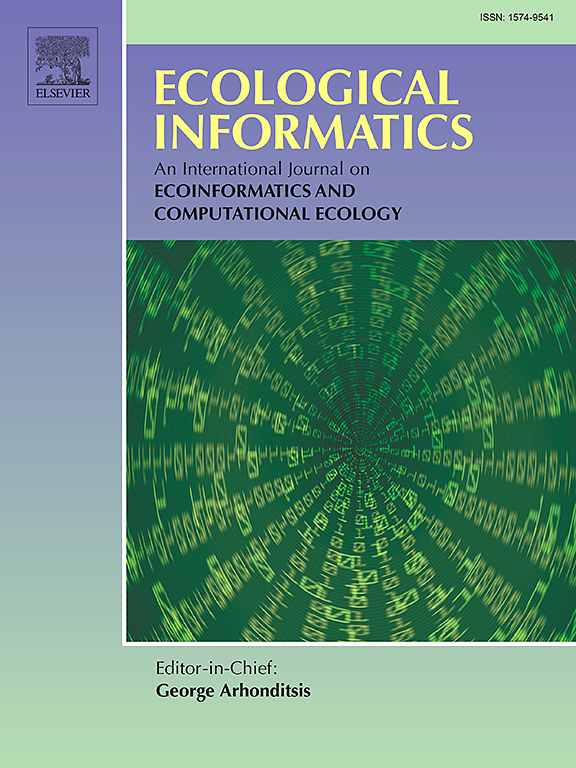A multi-source approach to mapping habitat diversity: Comparison and combination of single-date hyperspectral and multi-date multispectral satellite imagery in a Mediterranean Natural Reserve
IF 5.8
2区 环境科学与生态学
Q1 ECOLOGY
引用次数: 0
Abstract
The increasing availability of spaceborne hyperspectral satellite imagery opens new opportunities for forest habitat mapping and monitoring, but the limitation of its generally low temporal resolution must be considered. In this study, we compare the ability of single-date PRISMA (PRecursore IperSpettrale della Missione Applicativa), the hyperspectral satellite from the Italian Space Agency, with that of both single-date and multi-date Sentinel-2 (S2) and PlanetScope (PS) to detect and correctly classify various EUNIS habitat types distributed over a relatively small spatial extent (6000 ha) in a natural reserve in Central Italy. The case study deals with multiple levels of spectral similarity, as the dominant canopy species of the target forest habitat classes belong to the same genus (Quercus spp., both deciduous and evergreen species) as well as of different taxa (Pinus and Fraxinus spp.). We performed a pixel-based classification with the Random Forest algorithm using a set of 28 spectral indices computed on PRISMA bands, 22 on S2, and 12 on PS. A Canopy Height Model (CHM) was also used as an input variable for the classification. Our results showed that PRISMA considerably outperforms the two multispectral satellites in single-date classifications, with an overall accuracy of 84 % compared to PlanetScope's 69 % and Sentinel-2's 72 %. Regarding the comparison between multi-date multispectral and single-date hyperspectral, 10-fold cross-validation results revealed that S2 achieves an out-of-bag error rate of approximately 16 %, while PRISMA achieves 17 % and PS 19 %. This demonstrates that a combination of spectral indices calculated during the growing season can capture phenological or physiological differences among the target species, which consequently results in a significant improvement in the classification accuracy of the multispectral sensors. Ultimately, classification results from all three sensors were combined to create probability maps for each forest class, identifying areas classified with a higher degree of certainty by each satellite tested and potentially contributing to forest management by defining areas with varying conservation levels.
绘制生境多样性地图的多源方法:地中海自然保护区单日期高光谱和多日期多光谱卫星图像的比较与组合
越来越多的空间高光谱卫星图像为森林生境绘图和监测提供了新的机会,但必须考虑到其时间分辨率普遍较低的局限性。在本研究中,我们比较了意大利航天局的单日期高光谱卫星 PRISMA(PRecursore IperSpettrale della Missione Applicativa)与单日期和多日期 Sentinel-2(S2)和 PlanetScope(PS)在意大利中部一个自然保护区相对较小的空间范围(6000 公顷)内探测和正确分类各种 EUNIS 生境类型的能力。本案例研究涉及多层次的光谱相似性,因为目标森林生境类别的主要树冠树种既属于同一属(栎属,包括落叶和常绿树种),也属于不同类群(松属和梣属)。我们使用随机森林算法进行了基于像素的分类,该算法使用了一组在 PRISMA 波段上计算的 28 个光谱指数、在 S2 波段上计算的 22 个光谱指数和在 PS 波段上计算的 12 个光谱指数。树冠高度模型 (CHM) 也被用作分类的输入变量。结果表明,PRISMA 在单日期分类方面大大优于两颗多光谱卫星,总体准确率为 84%,而 PlanetScope 为 69%,哨兵-2 为 72%。关于多日期多光谱与单日期高光谱之间的比较,10 倍交叉验证结果显示,S2 的袋外误差率约为 16%,而 PRISMA 为 17%,PS 为 19%。这表明,在生长季节计算的光谱指数组合可以捕捉目标物种的物候或生理差异,从而显著提高多光谱传感器的分类准确性。最后,综合所有三种传感器的分类结果,绘制出每个森林类别的概率图,从而确定每个卫星测试分类确定度较高的区域,并通过界定不同保护级别的区域,为森林管理做出潜在贡献。
本文章由计算机程序翻译,如有差异,请以英文原文为准。
求助全文
约1分钟内获得全文
求助全文
来源期刊

Ecological Informatics
环境科学-生态学
CiteScore
8.30
自引率
11.80%
发文量
346
审稿时长
46 days
期刊介绍:
The journal Ecological Informatics is devoted to the publication of high quality, peer-reviewed articles on all aspects of computational ecology, data science and biogeography. The scope of the journal takes into account the data-intensive nature of ecology, the growing capacity of information technology to access, harness and leverage complex data as well as the critical need for informing sustainable management in view of global environmental and climate change.
The nature of the journal is interdisciplinary at the crossover between ecology and informatics. It focuses on novel concepts and techniques for image- and genome-based monitoring and interpretation, sensor- and multimedia-based data acquisition, internet-based data archiving and sharing, data assimilation, modelling and prediction of ecological data.
 求助内容:
求助内容: 应助结果提醒方式:
应助结果提醒方式:


